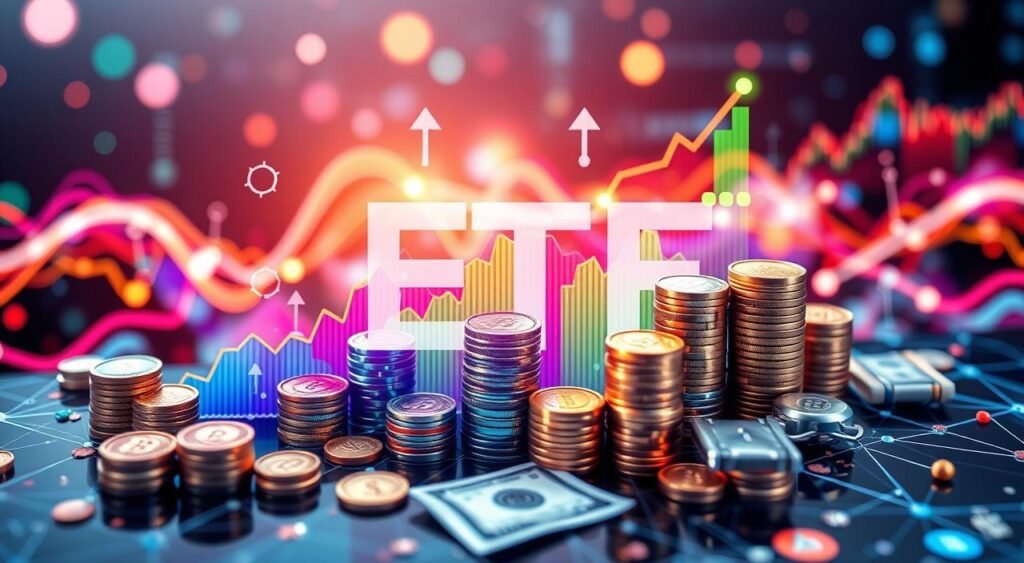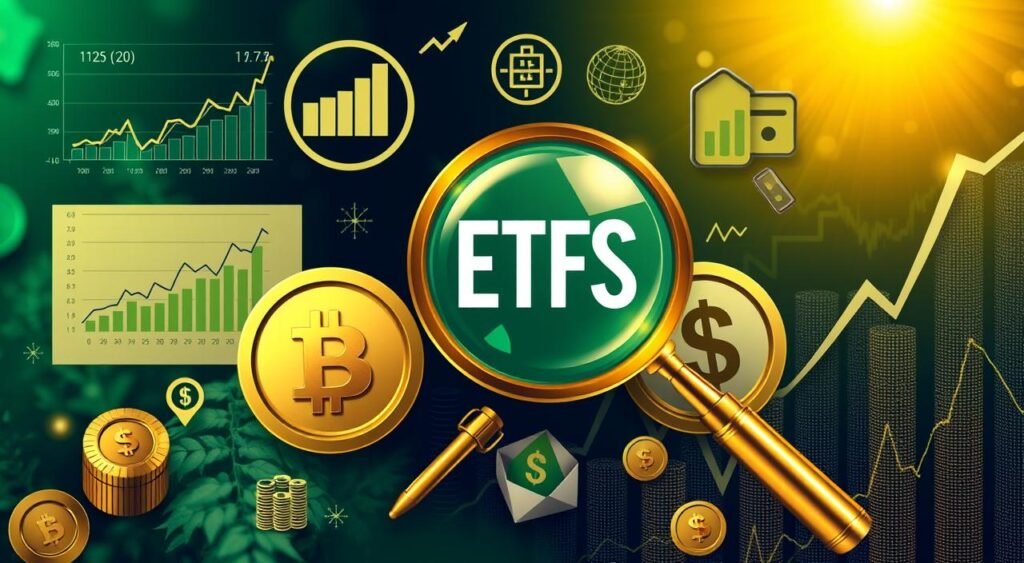Imagine waking up to a bright day, knowing your financial future is secure. Building a million-dollar portfolio with ETFs is possible and more accessible than you think. With careful investing, you can achieve financial freedom using ETFs.
Think back to the first time you reached a financial goal. Building a million-dollar portfolio with ETFs can give you that same feeling of success. This guide will help you start this rewarding journey with the tools and knowledge you need.
Exchange-Traded Funds (ETFs) are key to this strategy. They offer a simple way to diversify without the high costs of mutual funds. ETFs combine the benefits of stocks, bonds, and index funds, making them essential for growth.
ETFs make investing easy and efficient. They are great for beginners or those looking to improve their portfolio. By understanding ETFs, you can create a portfolio that matches your goals and risk level. Are you ready to build a million-dollar portfolio with ETFs? Let’s explore the steps to financial success.
Key Takeaways
- ETFs provide a cost-effective, transparent way to build a diversified portfolio.
- Building a million-dollar portfolio with ETFs is accessible through consistent investing.
- ETF investment options include a range of asset classes, regions, and sectors.
- Understanding the benefits and considerations of ETFs is key for smart investing.
- Setting clear financial goals is the first step in creating a successful ETF portfolio.
Introduction to Building a Million-Dollar Portfolio with ETFs

Creating a million-dollar portfolio needs careful planning and smart investment choices. Exchange-Traded Funds (ETFs) are great because they track indexes of different assets. This makes it easy to diversify your investments without much work.
Understanding ETFs
ETFs follow specific indexes, like stocks, bonds, or commodities. For example, the Vanguard Total Stock Market ETF (VTI) has a low expense ratio of 0.03%. This makes it a good choice for broad U.S. stock market exposure at a low cost.
ETFs like VTI, Vanguard Total World Stock ETF (VT) at 0.07%, and Vanguard FTSE Emerging Markets ETF (VWO) at 0.08% are great for long-term growth. Their low expense ratios help keep costs down.
Benefits of ETFs
ETFs are popular for many reasons:
- Diversification: They let you spread your investments across many asset classes. This reduces risk, which is good during shaky times.
- Cost Efficiency: ETFs usually cost less than mutual funds. For instance, the Vanguard Total International Bond ETF (BNDX) has an expense ratio of just 0.07%. This makes your portfolio more affordable.
- Transparency: ETFs clearly show their holdings. This makes it easier for investors to make informed choices.
Key Considerations
ETFs have many benefits, but there are also risks and things to think about:
- Market Volatility: ETFs can face big price changes due to market risks.
- Liquidity Risk: It might be hard to buy or sell ETF shares in thin markets.
- Expense Ratios: Even though lower than mutual funds, ETF expenses can add up. For example, the iShares 20+ Year Treasury Bond ETF (TLT) has an expense ratio of 0.15%. This could affect your returns over time.
If you’re thinking about ETFs, it’s key to read each fund’s prospectus. This will help you understand the risks and match them with your financial goals. For more on ETF investment options, check out Vanguard’s ETF investment options.
Advantages of ETFs in Portfolio Building
ETFs are great for building a portfolio. They help investors reach their long-term financial goals. Their benefits include diversification, low costs, and clear information.
Diversification
ETFs are good at spreading out investments. This reduces the risk of putting all money in one place. For example, the Vanguard Total Stock Market ETF covers the whole U.S. stock market.
This mix of stocks helps investors manage risk better. It can also improve their returns over time.
Low Expense Ratios
ETFs also have low costs. Funds like those from Vanguard and Schwab are cheaper than others. This means more money grows for the investor.
Lower costs help build wealth faster. Vanguard ETFs, for instance, can be bought without extra fees.
Transparency
ETFs are clear about what they hold. This lets investors make better choices. Knowing what’s in an ETF helps match investments with goals and risk levels.
The SPDR S&P 500 ETF Trust (SPY) is known for its openness. It shows its holdings every day. This is different from many other investments, making ETFs a smart choice.
Step-by-Step Guide to Building an ETF-Only Portfolio

Creating an ETF-only portfolio needs careful planning and smart choices. You must set your investment goals, decide on asset allocation, and pick the best ETFs.
Defining Your Investment Goals
First, figure out why you’re investing. Are you saving for retirement, a house, or just to grow your money? It’s wise to have an emergency fund of one to six months’ living expenses before investing.
Starting early is key. For example, a 25-year-old saving $5,000 and $300 each month could have about $1.04 million by 65.
Asset Allocation Strategies
Asset allocation is critical. It’s responsible for more than 90% of a portfolio’s gains, not the individual stocks. You can spread your investments across stocks, bonds, and other assets.
ETFs are great for this because they offer broad market access. Using dollar-cost averaging can also help you get better returns.
Choosing the Right ETFs
When picking ETFs, look at the criteria carefully. There are over 10,000 ETFs, with popular ones tracking the S&P 500 Index. Choose from well-known brands like iShares, Vanguard, and SPDR.
Consider the expense ratio, liquidity, and what the ETF covers. Diversifying your investments is key to a balanced, risk-adjusted return.
In summary, setting clear goals, using smart asset allocation, and picking the right ETFs are essential for a successful ETF-only portfolio. Remember, consistent saving and early investment boost your financial goals.
Top Performing ETFs for Long-Term Growth
Investors looking for long-term growth should check out different ETF categories. These include S&P 500 ETFs, International Stock ETFs, and Bonds and Fixed-Income ETFs. Each type has its own strengths and benefits that make them stand out.
S&P 500 ETFs
S&P 500 ETFs are known for their strong performance. They track the S&P 500 index. The SPDR S&P 500 ETF Trust (SPY) is a big player, with $568.7 billion in assets.
Vanguard’s S&P 500 ETF has a low expense ratio of 0.03%. This makes it a cost-effective choice. The Invesco S&P 500 Equal Weight ETF offers a unique approach by equally weighting each stock. Over 50 years, the S&P 500 index has averaged a 9.4% annual return, showing its growth promise.
International Stock ETFs
International Stock ETFs offer a chance to invest in both developed and emerging markets. This adds diversity to a portfolio. The SPDR Portfolio Developed World ex-US ETF (SPDW) focuses on markets outside the U.S. and has $21.4 billion in assets.
The iShares Core MSCI EAFE ETF is another top choice, with an expense ratio of 0.07%. It has a significant presence in Japan, the U.K., and France. The iShares Core Growth Allocation ETF also includes emerging markets, adding to its appeal.
Bonds and Fixed-Income ETFs
Bonds and Fixed-Income ETFs are key for a balanced long-term strategy. They offer stability and income. The iShares Core Total USD Bond Market ETF is a big part of diversified portfolios, making up 33.3% of the iShares Core Growth Allocation ETF.
The Schwab U.S. Dividend Equity ETF is great for those seeking income, with a 3.5% dividend yield. These fixed-income assets help manage risk and return, vital for long-term growth.
By mixing these top-performing ETFs into a diversified strategy, investors can boost their chances of long-term success.
ETF Selection Criteria: How to Choose the Best Funds
Choosing the best ETFs means knowing key factors for a strong portfolio. With over 3,000 ETFs listed in the U.S. and assets over $7.6 trillion, picking wisely is essential.
Performance history is a key factor. Looking at past returns shows if the fund is reliable. Also, the expense ratio matters. Lower ratios mean more money in your pocket.
Liquidity is important too. High trading volumes mean easier buying and selling. Aim for ETFs with at least $10 million in assets for better liquidity.
Passive investing fans should check how well an ETF tracks its index. Small differences can impact performance. Also, make sure the ETF’s assets match your investment goals.
The company behind the ETF matters too. Reputable issuers offer stability and clear information, important for good investments.
In short, look at performance, low costs, liquidity, tracking errors, and the issuer’s reputation. These help you choose the right ETF for your strategy. This way, you can make smart choices for your investments.
“Investing in ETFs requires thorough research and an understanding of various selection criteria to ensure long-term profitability and alignment with personal investment goals.”
Investment Strategies for a Diversified ETF Portfolio

Building a diversified ETF portfolio is key to lowering risk and getting steady returns. There are many ways to diversify and boost your portfolio’s performance.
Core-Satellite Strategy
The Core-Satellite Strategy starts with a strong base (core) of broad-market ETFs, like those following the S&P 500. Then, it adds satellite positions. These are focused ETFs that might offer better returns. This mix keeps your portfolio stable while reaching for growth.
“Approximately allocating investments in about 20 to 30 different vehicles is recommended for a manageable portfolio.” – Investopedia
Sector Rotation
Sector Rotation is a flexible method. It moves investments between sectors based on the economy’s cycles. By keeping up with market trends and economic signs, you can make your portfolio better. This way, you can catch the winners and avoid the losers.
Research shows that 80% of the damage happens before most investors react. This makes quick, smart sector shifts very important.
Global Diversification
Global Diversification takes your portfolio beyond your home market. It spreads your investments across different countries. This reduces risk and makes your portfolio more resilient against local ups and downs.
Strategies like the Core-Satellite, Sector Rotation, and Global Diversification offer different paths to a strong portfolio. Using these methods helps investors manage risks and reach their financial goals through ETFs.
High-Return ETFs and Their Role in Portfolio Management
High-return ETFs are key for investors wanting to grow their portfolios. But, it’s important to know the risks and rewards. These ETFs can be volatile, so managing them well is essential.
Understanding Risk and Reward
Investing in high-return ETFs has its pros and cons. The chance for big gains is tempting, but so is the risk. Morningstar’s ratings help investors see how well an ETF does compared to others.
Most Gold-rated ETFs are low-cost and passively managed. They’re great for those looking for growth. For instance, Global X SuperDividend ETF (SDIV) has a 10.7% dividend yield but costs 0.58% in fees.
Balancing High-Return ETFs in a Portfolio
Managing a portfolio well means mixing high-return ETFs with stable ones. Large-cap U.S. stock ETFs, like Vanguard Dividend Appreciation ETF (VIG), provide a solid base. They have a 1.7% yield.
International stock ETFs, like iShares International Select Dividend ETF (IDV), offer a 6.2% yield. They help balance U.S.-specific risks. Bonds, such as SPDR Bloomberg High Yield Bond ETF (JNK), also play a role. They have a 7.5% yield and help manage risk, even with shorter investment timelines.
The aim is to balance high-return ETFs with other assets. This mix helps manage risk and boosts performance. Funds like Invesco CEF Income Composite ETF (PCEF) and iShares Preferred & Income Securities ETF (PFF) add value while keeping the portfolio diverse.
Using Index-Tracking ETFs for Passive Investing

Index-tracking ETFs are key in passive investing. They aim to mirror the performance of a market index, like the S&P 500. This approach lets investors diversify their market exposure without the need for constant management. It’s a cost-effective way to work towards long-term financial goals.
In the early 2000s, stock-index-tracking ETFs made up just 8% of passive equity assets. But by 2010, they were nearly half of all indexed money. By the first half of 2024, ETFs made up 80% of passive equity inflows. This shows a big move towards passive investment strategies.
Index-tracking ETFs offer more than just cost savings. They are simple and transparent, making it easy for investors to know what they own. Indexes like the S&P 500, with its 500 top U.S. companies, are often followed by these ETFs. This provides consistent returns that match the market’s performance.
Many index funds are great for building a strong portfolio. For example, the Vanguard S&P 500 ETF has a very low expense ratio of 0.03%. This means just $3 a year on a $10,000 investment. Such affordability helps investors keep more of their earnings, making index-tracking ETFs even more appealing.
ETFs have seen huge growth, from $204 million to nearly $10 trillion by 2021. This is much faster than mutual funds, which have grown 130% in 15 years. ETFs have grown over 20 times in the same period, showing their big role in investing.
Nearly 50% of U.S. investments are through ETFs. This shows how big index-tracking ETFs are in passive investing. As more people look for efficient, low-cost ways to grow their portfolios, ETFs will likely become even more popular.
ETF Portfolio Management and Rebalancing

Keeping your ETF portfolio balanced is key to reaching your investment goals and managing risks. Regular rebalancing is essential for ETF portfolio management. It helps keep your asset allocation on track, even when the market changes.
When to Rebalance
Knowing when to rebalance your ETF portfolio is important. You should watch how your portfolio is doing against your goals. For example, a 60/40 mix of stocks and bonds might need adjusting if the market shifts.
Studies show a 60/40 portfolio has made about 9% a year for a century. This highlights the importance of rebalancing to stay on track.
Tools for Managing an ETF Portfolio
Many tools and platforms help with ETF portfolio management and rebalancing. These tools are key for keeping your assets in balance and tracking performance. For instance, the iShares Core Aggressive Allocation ETF (AOA) offers a mix of 80% stocks and 20% bonds.
AOA has nearly $2 billion in assets, showing how diversification can be achieved with specific ETFs. Using such funds can make diversifying your portfolio easier.
The US ETF market has grown 18.8% annually after the Great Financial Crisis. Today, there are more tools for rebalancing, like automated services and risk management tools. These platforms help investors adjust their portfolios to market changes while keeping costs low, like AOA’s 0.15% expense ratio.
As rebalancing strategies improve, the value of using ETFs becomes clearer. They offer transparency, easy execution, and effective risk management. So, it’s important to stay up-to-date with rebalancing techniques for your ETF portfolio’s success.
Conclusion
Building a million-dollar portfolio with ETFs is possible with the right strategy. ETFs offer diversification, cost-efficiency, and transparency. They help investors grow their wealth over time.
ETFs have shown a 4-6% return over the last decade. This is better than real estate, which has a 5% return but comes with risks. Stock investments offer dividends around 2%, which are tax-free for those in the right bracket. This makes ETFs a smart choice for building a large portfolio.
Many have found success with ETF portfolios. As investors gain experience, they might choose to invest directly in ETFs to save money. ETFs provide a stable way to grow your wealth with ease and low costs.
For more on building a million-dollar portfolio with ETFs, check out this detailed guide.
FAQ
What is an ETF and how does it work?
An ETF, or Exchange-Traded Fund, tracks an index or a basket of assets. It trades like a stock, allowing investors to buy and sell at market prices. This makes it easy to invest in a variety of assets.
What are the benefits of investing in ETFs?
ETFs offer diversification and low costs. They help spread risk across different assets. This makes them a good choice for both new and experienced investors.
How do I start building a diversified ETF portfolio?
First, know your investment goals and risk level. Then, choose ETFs that fit your desired market exposure. Look at their past performance, costs, and how well they track their indexes.
What are some top-performing ETFs for long-term growth?
For long-term growth, consider S&P 500 ETFs and International Stock ETFs. Bonds and Fixed-Income ETFs are also good for steady returns.
What criteria should I consider when selecting ETFs?
Look at their performance, costs, and how well they track their indexes. Also, check the ETF’s composition and the company’s reputation. Make sure it fits your investment goals and risk level.
How do high-return ETFs fit into my portfolio?
High-return ETFs can grow your portfolio but are riskier. Balance them with stable investments to manage risk. It’s important to understand the risks and rewards of these ETFs.
What are index-tracking ETFs and their benefits?
Index-tracking ETFs aim to match a specific market index, like the S&P 500. They are simple, cost-effective, and suitable for passive investing. They can help you grow your portfolio over time.
When should I consider rebalancing my ETF portfolio?
Rebalance your ETF portfolio regularly to keep your asset allocation right. This involves checking performance and adjusting holdings as needed. It helps manage risk and stay on track with your investment goals.
What tools can help manage an ETF portfolio?
Many tools and platforms can help manage your ETF portfolio. They include software for tracking performance, rebalance alerts, and platforms with data and analytics. These tools can help you make informed decisions and optimize your portfolio.












